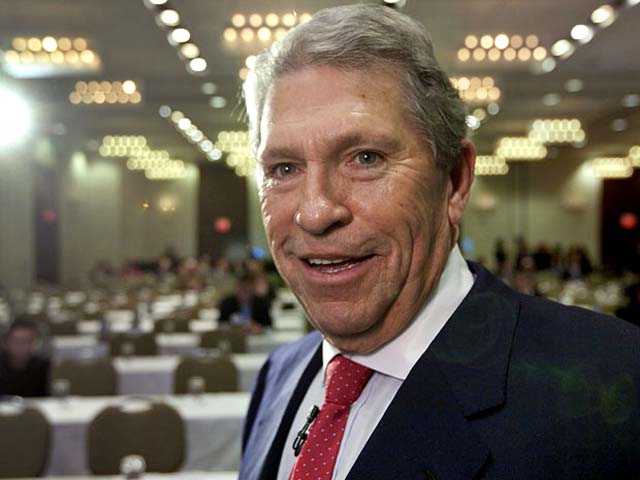
2012
|


E. Hunter Harrison - Date/Photographer unknown.
2 July 2012
Joy Trepidation Fear at CP all at the Same Time
New York New York USA - The worst kept secret in the railroad industry for more than a month has been the identity of the new chief
executive of Canadian Pacific Railway. For the record, E. Hunter Harrison was named president and chief executive of CP on Friday, 29 Jun 2012.
It is a bit of a puzzle why it took the newly constituted CP board more than a month to determine that Harrison was the right person to take over Canada's
second-largest rail system and one of just seven Class I railroads in North America.
Some thought he would be named to the dual posts after the 17 May 2012 resignations of Fred Green the previous CEO, and John Cleghorn CP's board chairman. Few
call it a resignation, most accept that the two top executives were dismissed after a several month, vigorous proxy battle for control. Green and Cleghorn were
on the losing side.
The assault on propriety, as some Canadian Brahmins might call it, came after activist New York investor Bill Ackman and his Pershing Square Capital Management
hedge fund acquired 14 percent of CP's common stock. CP had turned in a dreadful operating ratio above 90 in the first quarter of 2011. Activist? You bet.
Ackman called for the dismissal of Green and offered a slate of director candidates that would give him effective control of CP. A properly managed CP would
earn more and Ackman's investment would be worth more.
The board unanimously supported Green. When two prominent institutional stockholder advisory services recommended that stockholders vote for the Ackman slate,
the battle was effectively over.
What went wrong? CP long was considered the better railroad than CN, although the sterling reputation probably outlasted reality by several years. But CP only
had to be a little better than CN to be considered the gold standard of Canadian railroading. And that's what it turns out it really was, just a little better.
If one wishes to quibble over semantics, the reality probably was not that CP was better, but that CN was worse.
CN had an excuse, though. It was a crown corporation, what Canada calls nationalized companies. CN was turned over to a highly regarded Canadian politician and
former cabinet secretary (minister?) in 1992. He engineered the railroad's privatization in 1995. One legislator from the opposition party said: CN would
be successful when pigs fly. Paul Tellier, the former government official who initially headed the railroad, commissioned a book telling how CN became
profitable. It pointedly was titled: "The Pig That Flew".
CN was expansionist. It first acquired the Illinois Central, where Hunter Harrison happened to be president and CEO. IC accepted CN's offer in 1998 and the
deal was consummated in 1999. CN now was a rail system stretching from Halifax, Nova Scotia, on the Atlantic, and stretching to Vancouver and Prince Rupert on
the Pacific, and to the U.S. Gulf of Mexico coast.
CN then tried to combine with Burlington Northern Santa Fe in 1999, but the transaction was derailed by the combined opposition of four Class I railroads
CSX, Canadian Pacific, Norfolk Southern, and Union Pacific.
After Harrison became CN's chief operating officer, he soon began to make changes. What some called a scheduled railroad, Harrison preferred to call a
"disciplined" railroad. It was really quite simple.
If a train was scheduled to depart a yard at a certain time, Harrison demanded that the appropriate power be fueled and coupled and the crew ready for duty.
Supervisor heads might roll if this were not done. It was not long before CN began to offer shippers car supply guarantees. It did not guarantee every request
for cars, but if planners knew when cars were going to be available, they made the service commitment. The idea was that if you knew where your equipment was
supposed to be, and when, you could guarantee it to the next shipper that wanted that car type. CN offered a penalty for failure to spot a guaranteed car when
promised, and it exacted a penalty from shippers that asked for and accepted guaranteed cars and then failed to load and release them when they were required
to do so.
CN eventually was able to return some 800 leased locomotives to their owners, a huge saving on operating expenses. A disciplined operation gets far greater use
of its assets than a non-disciplined railroad. The operating ratio of expenses to revenue (OR) began to drop like a stone and soon was the lowest (lower is
better) in the industry. Earnings increased, stock price soared, and dividends to stockholders were increased.
Not everyone thought Harrison was the greatest railroader of all time, and many still do not. Shippers resented the discipline that he imposed on them.
Harrison reviewed the business it did with many shippers and arbitrarily changed the number of switches their volume justified each week. Going back to the
days of state ownership, CN virtually had given the store away, and the expense-reducing change was a shock to many.
Some CP workers dread the coming of a man few ever have met. Somehow, Harrison's hard line with supervisors and customers had morphed into a reputation among
many rail workers as a martinet.
When Tellier retired, Harrison was the logical successor as president and chief executive.
Harrison retired in 2009, and CN remained the best operated railroad under Claude Mongeau, the young former CN chief of strategic planning.
When Ackman launched his assault on CP, he didn't just call for Green to be replaced. He offered Harrison as the replacement. CN did not like that at all and
filed suit in a U.S. federal court seeking to negate Harrison's pension and other financial provisions in his retirement agreement. Ackman committed to
indemnify Harrison for any losses he might suffer.
When CP finally named Harrison its new chief, CN pointedly offered its congratulations and simultaneously made clear that the suit still was pending.
CP is the third Class I Harrison has headed, and the fifth for which he has held officer rank. He started his career on the St. Louis-San Francisco Railway
(Frisco), became an operating vice president of the Burlington Northern after it acquired the Frisco, then moved to the top job at IC.
At 68, it is likely that Harrison will be at CP only long enough to begin a major change in the way the business is managed, then will leave it to a younger
executive to finish the job.
Larry Kaufman.


 This web site was assembled on Vancouver Island in British Columbia Canada. This web site was assembled on Vancouver Island in British Columbia Canada.
|


